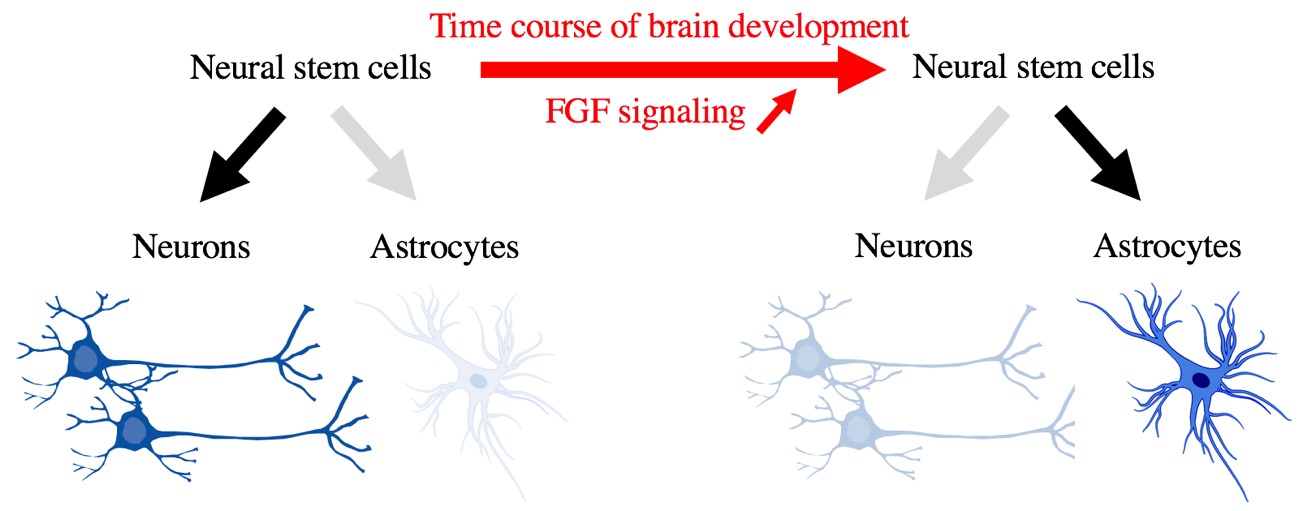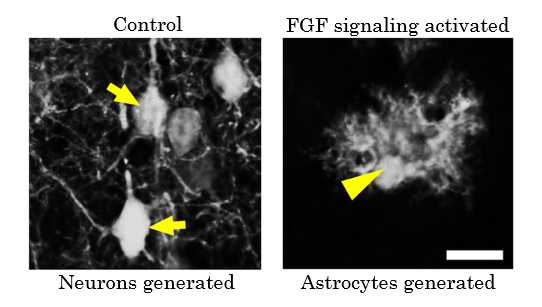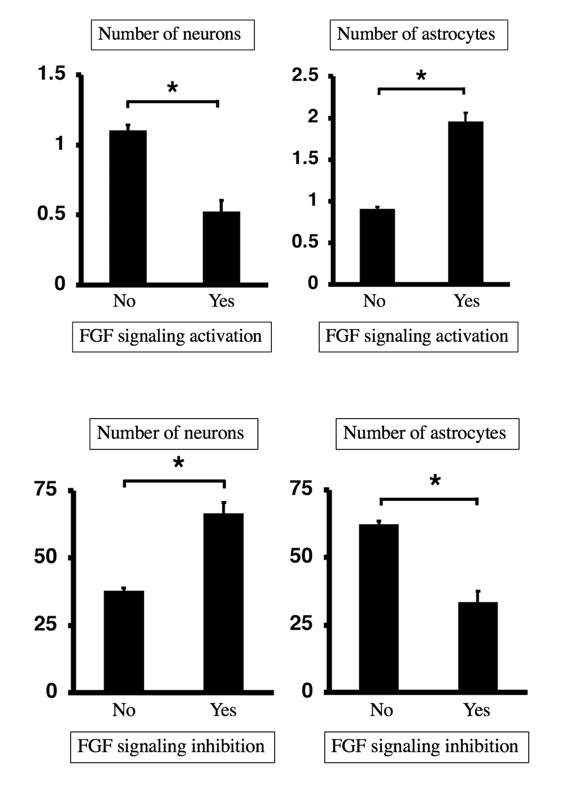Abstract:
During mammalian brain development, neural precursor cells first generate neurons and later astrocytes. This cell fate change is a key process generating proper numbers of neurons and astrocytes. Here we discovered that FGF regulates the cell fate switch from neurons to astrocytes in the developing cerebral cortex using mice. FGF is a critical extracellular regulator of the cell fate switch, necessary and sufficient, in the mammalian cerebral cortex.
[Background]
Neurons*1) and astrocytes*2) are prominent cell types in the cerebral cortex. Neurons are the primary information processing cells in the brain, whereas astrocytes support and modulate their functions. For sound functioning of the brain, it is crucial that proper numbers of neurons and astrocytes are generated during fetal brain development. The brain could not function correctly if only neurons or astrocytes were generated.
During fetal brain development, both neurons and astrocytes are generated from neural stem cells*3), which give rise to almost all cells in the cerebral cortex (Figure 1). One of the characteristics of this developmental process is that neural stem cells first generate neurons and, after that, start generating astrocytes (Figure 1). The “switch” to change the cell differentiation fate of neural stem cells from neurons to astrocytes has attracted much attention, since the cell fate switch is key to the generation of proper numbers of neurons and astrocytes. However, it remained largely unknown.
[Results]
The research group at Kanazawa University show that the switch determining the fate of two types of cells in the cerebral cortex generated from neural stem cells is based on the FGF signaling pathway (Figure 1). More specifically, it was found that enhancement of FGF signaling by introducing FGF in the cerebral cortex caused cells destined to become neurons to be differentiated into astrocytes (Figures 2, 3). On the other hand, suppression of FGF signaling caused cells destined to become astrocytes to be differentiated into neurons (Figure 3).
The present study has thus elucidated the mechanism responsible for determining the correct numbers of neurons and astrocytes during development of the fetal brain.
[Future prospects]
The research group has discovered the switch that determines the fate of cells in the developing cerebral cortex generated from neural stem cells, i.e. neurons and astrocytes; this switch involves the FGF signaling pathway. This may be relevant for understanding the pathology of brain disorders caused by unbalanced numbers of neurons and astrocytes by determining which disorders are based on abnormal FGF signaling.

Figure 1. Differentiation of neural stem cells into neurons and astrocytes during the process of brain formation.
In the process of fetal brain development, neural stem cells generate both neurons and astrocytes. Neurons are formed first (left) and astrocytes later (right). The present study has revealed the cell fate switch from neurons to astrocytes to be FGF signaling.

Figure 2. FGF signaling activation affects the number of cells generated from neural stem cells.
Under the condition where neural stem cells give rise to neurons (arrows, left), activation of FGF signaling caused generation of more astrocytes (arrowhead, right).

Figure 3. Changes in cell numbers of neurons and astrocytes in response to the change of FGF signaling.
Activation of FGF signaling causes fewer neurons to be generated (upper left) but more astrocytes are formed (upper right). On the other hand, when FGF signaling is inhibited, more neurons are generated (lower left) but fewer astrocytes (lower right).
[Glossary]
*1) Neuron
Neurons are the cells that primarily perform information processing in the brain. When neuronal functions are impaired, e.g. in various diseases, brain functions deteriorate, resulting in various symptoms such as memory decline and other neurological and behavioral disorders.
*2) Astrocyte
Cells other than neurons in the brain are collectively called glial cells. A major type of glial cell is the astrocyte or astroglia, so-called due to their star-like shape. Astrocytes are known to support neurons by supplying nutrients, removal of metabolic wastes, as well as modulating their electrical activity.
*3) Neural stem cell
Neural stem cells are self-renewing multipotent cells that generate neurons and glial cells. During the course of brain development, neural stem cells first generate neurons and then change so as to generate astrocytes later.
*4) FGF
Fibroblast growth factor (FGF) is a protein signaling molecule. FGF has been known to have functions such as stimulating cell proliferation (division) and supporting cell survival. The present study has revealed a new function for FGF in determining the fate of new cells in the cerebral cortex from neural stem cells: from neurons to astrocytes.
Article
FGF signaling directs the cell fate switch from neurons to astrocytes in the developing mouse cerebral cortex
Journal: The Journal of Neuroscience
Authors: Tung Anh Dinh DUONG, Yoshio HOSHIBA, Kengo SAITO, Kanji KAWASAKI, Yoshie ICHIKAWA, Naoyuki MATSUMOTO, Yohei SHINMYO and Hiroshi KAWASAKI
DOI: 10.1523/JNEUROSCI.2195-18.2019
Funder
Grants-in-Aid for Scientific Research from MEXT, Kanazawa University SAKIGAKE project 2018, Kanazawa University CHOZEN project, Takeda Science Foundation, Mitsubishi Foundation.



 PAGE TOP
PAGE TOP